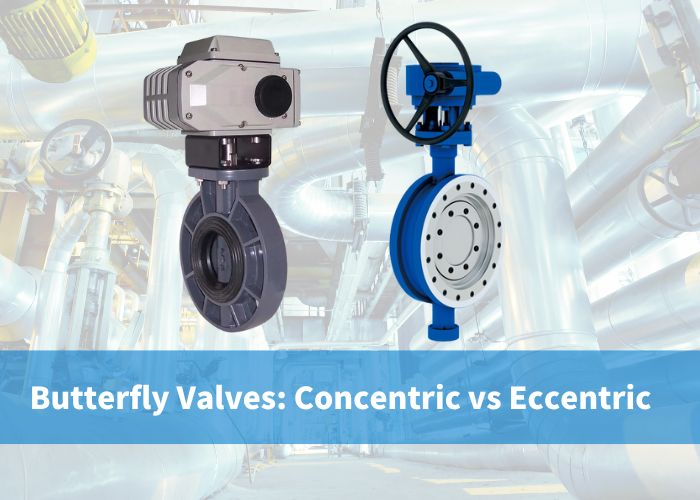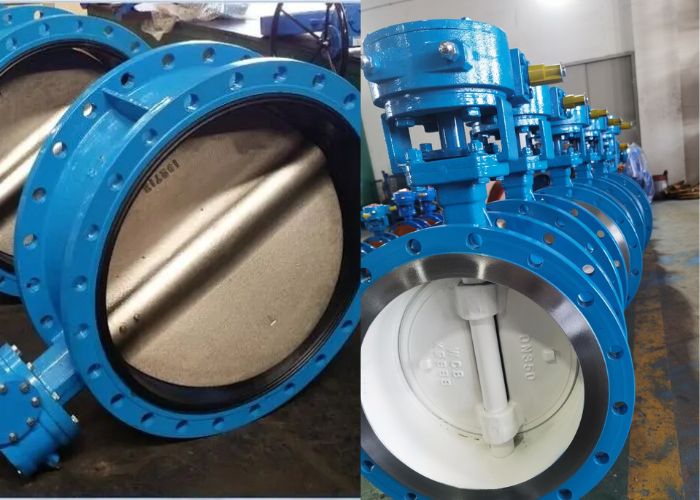
When it comes to fluid control and regulation in various industries, butterfly valves have emerged as reliable and versatile components. These valves play a crucial role in managing the flow of liquids and gases, ensuring smooth operation in pipelines, and preventing leakage. Among the various types of butterfly valves, two fundamental designs stand out: concentric and eccentric butterfly valves. In this blog, we’ll take a deep dive into the world of butterfly valves, comparing and contrasting these two essential variants to help you understand their applications, advantages, and limitations. Whether you’re an engineer, a technician, or simply someone curious about industrial valves, this exploration will shed light on the key differences and applications of concentric and eccentric butterfly valves, equipping you with valuable knowledge for your fluid control needs. Let’s open the valve on this fascinating topic and discover which type suits your specific requirements.
What is Concentric Butterfly Valve?
The concentric butterfly valve is a flow control mechanism that controls the flow medium in the system with a rotary disk. The disk remains in the passage, but due to its thinness, it provides little impediment to the flow.
Butterfly valves have various advantages over other types of valves, including cost-effective construction with fewer components, making them easier to operate and maintain. The wafer design body’s light weight and low cost cut installation costs, equipment, pipe support, manpower, and set-up time.
A centric or concentric butterfly valve configuration is the most prevalent form of butterfly valve layout. The stem of this sort of butterfly valve travels along the middle line of the disk in the center of the pipe bore, and the seat is the inside diameter of the valve’s body. Because the seal’s dependability is based on the flexibility of the seat rubber when the flow is closed, this no offset valve design is also known as a resilient-seated valve. The disk first interacts with the seat at roughly 85° for a 90° revolution in this sort of valve. In low-pressure applications, concentratic butterfly valves are commonly employed.
Classification by connection type
§ Wafer type ends.
§ Lug type ends.
§ Both flanged ends.
§ Butt-welded types end.
How Does Concentric Butterfly Valve Work?
Concentric butterfly valves have a relatively simpler design. The primary components of the concentric butterfly valve are the body, seal, disc, and stem.
The traditional butterfly valve has a disk in the middle of the attached pipe, and a stem is connected to the actuator or handle on the outside of the valve. When the valve is in a closed position, the disk is perpendicular to the flow, and the valve seat is shut. The stem is sealed with an O-ring. When the valve makes a turn of 90 degrees with the help of an actuator or handle, the disk travels away from the valve seat and is located parallel to the flow. The rotation at an angle less than 90 degrees allows the flow to be either throttled or proportional.
Advantages of a Concentric Butterfly Valve
§ One of the best things about concentric butterfly valves is that they use a neutral seal structure.
§ Close to the rubber seat ring, the lower and higher ends of the disc at the valve stem have two very smooth flat surfaces. This prevents the medium from leaking.
§ The disc gradually compresses while rotating while the valves are closed. As a result, the seat ring deforms elastically.
Disadvantages of Concentric Butterfly Valves
§ Due to its structural properties, one of the biggest disadvantages of employing a concentric butterfly valve is that it can only be turned into a soft seal butterfly valve.
§ These valves are only suitable for standard and low-pressure applications and are not suitable for high-pressure or high-temperature applications.
When to Use Concentric Butterfly Valve?
Because concentric butterfly valves use soft sealing material, they can only be used in basic (water and wastewater treatment plant), special liquid (chemicals, abrasive liquids, etc.), and gases with pressures up to 200 psi and temperatures up to 400 degrees Fahrenheit.
§ Water treatment.
§ Water Distribution.
§ Water Transmission.
§ Aeration System.
§ Fire Protection, etc.

What is an Eccentric Butterfly Valve?
An eccentric butterfly valve is a type of industrial valve designed for precise control and regulation of fluid flow within pipelines. Unlike its concentric counterpart, which has its shaft in the center, the eccentric butterfly valve’s shaft is offset from the center of the valve disc. This unique design allows for a tighter seal and better flow control, making it ideal for applications requiring bubble-tight shut-off and high-performance throttling capabilities. Eccentric butterfly valves are commonly used in petrochemical, water treatment, and HVAC systems, where precision in flow control and minimal leakage are paramount.
Advantages of an Eccentric Butterfly Valve
§ An eccentric butterfly valve employs hard metal sealing, which is a cutting-edge valve technology. The valve seat and body are joined in this case, and the valve seat sealing surface is covered with anti-corrosion and heat-resistant alloy steel.
§ These valves can operate in high-temperature environments and feature rapid and frictionless closing and opening.
Disadvantages of an Eccentric Butterfly Valve
§ Because of the multi-layered soft and hard stacked sealing ring mounted on the valve plate, the medium causes positive erosion on the sealing surface when it is opened on a frequent basis. If the soft sealing ring washed off into the metal plate interlayer, the sealing efficiency would be quickly compromised.
§ Due to structural limits, this butterfly valve seat construction is not suitable for valves with a diameter less than DN200, as the overall shape of the valve plate is thicker and has a higher flow resistance. The torque of the transfer mechanism drives the valve plate towards the valve seat in the triple eccentric butterfly valve structure, and a seal forms between the plate’s sealing surface and the valve seat.
§ When the flow medium is reversed, the seal leaks because the unit positive pressure between the valve plate and the seat is less than the system pressure.
When to use an Eccentric Butterfly Valve?
§ High-Performance Throttling: Eccentric butterfly valves excel in applications where precise control of flow and throttling is essential. Their offset shaft design allows for better flow modulation compared to concentric butterfly valves, making them suitable for systems that require fine-tuned flow control.
§ Bubble-Tight Shut-Off: When a tight shut-off is critical to prevent leakage in the pipeline, eccentric butterfly valves are a preferred choice. Their design ensures a secure seal, reducing the risk of fluid leakage when the valve is in the closed position.
§ High-Pressure Systems: Eccentric butterfly valves can handle higher pressures compared to concentric butterfly valves. They are often used in applications with elevated pressure levels, such as in petrochemical, oil and gas, and industrial processes.
§ Large Pipe Diameters: These valves are available in larger sizes, making them suitable for applications with large pipe diameters where flow control and shut-off are required.
§ Chemical and Corrosive Environments: Eccentric butterfly valves can be constructed with materials resistant to corrosion and chemical attack. This makes them suitable for use in industries dealing with aggressive media or corrosive environments.
§ Water Treatment: In wastewater treatment plants and similar facilities, eccentric butterfly valves are often chosen for their reliability in controlling the flow of water and chemicals.
§ HVAC Systems: Eccentric butterfly valves are commonly used in heating, ventilation, and air conditioning (HVAC) systems to regulate the flow of air and water. Their compact design and precise control are advantageous in HVAC applications.
§ Fire Protection Systems: In fire protection systems, where quick and reliable valve operation is crucial, eccentric butterfly valves with grooved connections are often used due to their ease of installation and maintenance.
Concentric vs. Eccentric Butterfly Valve: What are their Differences?
Knowing the difference between a concentric and eccentric butterfly valve. The wrong type of valve can interrupt the entire operation. There are several varieties of valves on the market, including concentric and eccentric butterfly valves. Both of these valves are not only visually distinct but also internally distinct.
§ A seal retaining ring, disc seal, and retaining bolt are used in conjunction with an eccentric butterfly valve disc. The centerline butterfly valve, on the other hand, is just a regular disc.
§ The sealing of the eccentric butterfly valve has an extra laminated disc seal connected with a meat body seat. The midline butterfly valve, on the other hand, has a fairly simple sealing where the disc immediately hits the rubber seat.
§ The eccentric butterfly valve is a meat seat, whereas the centerline butterfly valve is a soft seal with a replaceable welded seat.
§ Because the designs of these valves are so dissimilar, the rubber seal of the centerline butterfly valve cannot withstand the high temperature. The butterfly valve, on the other hand, performs well with a hard seal design.
§ The maximum temperature of a butterfly valve is 150LB/PN25 pressure. Eccentric butterfly valves, on the other hand, can withstand pressures of up to 600LB/PN100.
Which one is Better? A Concentric or an Eccentric Butterfly Valve?
The choice between a concentric and an eccentric butterfly valve hinges on your specific application requirements. Concentric butterfly valves are cost-effective and suitable for general applications but may not provide absolute shut-off or precise flow control. Eccentric butterfly valves, on the other hand, excel at bubble-tight shut-off and precise flow modulation, making them ideal for critical applications, especially those with high-pressure demands. However, they tend to be pricier. Ultimately, the “better” choice depends on your priorities: cost-effectiveness for standard applications favors concentric valves, while absolute sealing and precision in flow control favor eccentric valves for critical systems.






